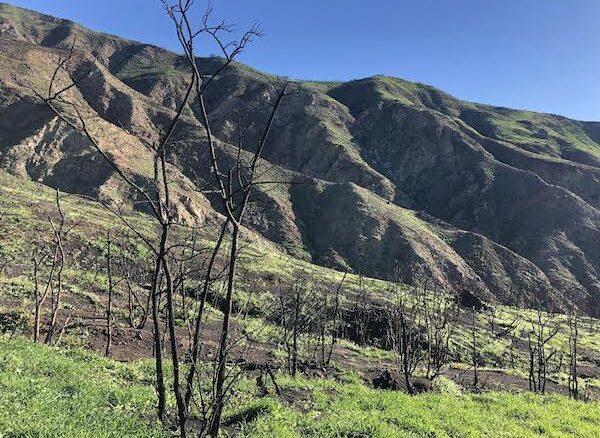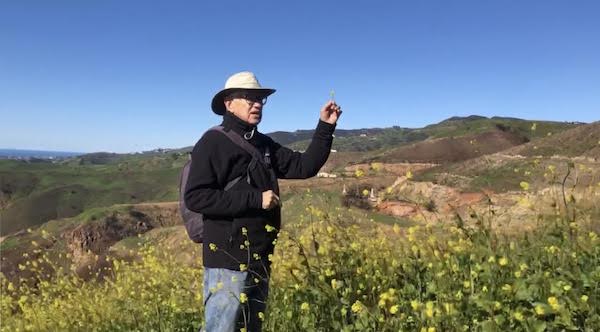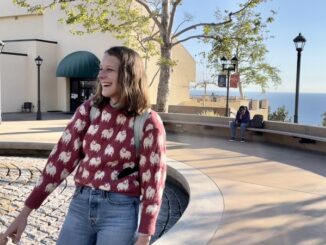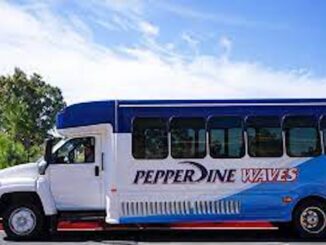
An extensive plant ecosystem rarely found in the rest of the world exists right in Pepperdine’s backyard and it’s becoming increasingly threatened.
Biology Professor Stephen Davis has studied the plant life, particularly chaparral, at Pepperdine since his employment in the 1970s. An increase in fire frequency and human intervention has led to the decline of these important plants, causing invasive weeds to slowly take over.
“When you lose species, like the fires become too frequent, then that allows invasive weeds to invade and the problem with that is that they’re more flammable, more flashy fuel, more easily ignited,” Davis said. “Also, they blow long distances, and that’s the primary cause of structural damage. So all of this kind of propagates itself.”
Because the campus is located in the middle of an area with high biodiversity, the ecosystem is fragile, Davis said. These plant species play a vital role in fire and landslide prevention, meaning the campus is at an increased risk without them. Pepperdine officials have a checkered history in protecting plant life and experts said more can be done.
Fire frequency in a hotspot of biodiversity
California is one of 34 biodiversity hotspots in the world, which in total make up 3 percent of the earth’s surface, according to the California Academy of Sciences. A biodiversity hotspot is an ecosystem that contains many unique and diverse plant and animal life.
The most dominant plant species in California’s ecosystem is chaparral. Chaparral are characterized by their deep roots and their fire-resistant leaves, which can be waxy, leathery or fuzzy depending on the plant, according to the National Parks Service. The leaf structures make the plants less flammable. Their deep roots both prevent the plant from being killed by fire and help stabilize the soil during the rainy season that often immediately follows wildfires.

The chaparral that are most common include laurel sumac, purple needlegrass, chamise, scrub oak, big-berry manzanita, ceanothus and more. Pepperdine’s landscape hosts a large quantity of laurel sumac and purple needlegrass, although recently, numbers have been dwindling.
Shorter times between fires might eliminate some chaparral species while others might become less dense, ultimately changing the plant community structure in the Santa Monica Mountains, according to a 2016 study Davis and his colleagues did.
These plants are losing numbers “rapidly” to invasive weeds and human-caused fires, Davis said.
This phenomenon of a native plant species losing to an invasive species is known as vegetation type conversation. This means that the natural vegetation is converted to something different over time, Davis said. In California and in Pepperdine’s backyard, this means an increased risk of fires.
“It is no longer beautiful chaparral vegetation, it’s now exotic grasses, these flashy fuels that support fire,” Davis said. “What that does is cause habitat fragmentation, where the natural habitat for all these wonderful animals we have, that makes it more difficult for them to live.”
Natural species recovery attempts at Pepperdine
Government entities regulate plant species on Pepperdine’s campus as part of protected coastal area.
“Our relationship with the LA county and with the California Coastal Commission, which governs what plants we do put on campus, mandates that we have a certain native [plant species] to non-native ratio,” said Religion Professor Christopher Doran, who teaches multiple courses for the sustainability minor at Pepperdine. “There are certain regulations we have to keep …We are trying to remain in compliance with those as much as we can.”
Pepperdine’s history with the commision is long and detailed. In 1999, Pepperdine introduced a Long Range Development Plan to the California Coastal Commission that created seven revisions to the campus. Included in these revisions was the building of Drescher Graduate School.
The Commission rejected the plan on the grounds that it did not meet the standards of the Coastal Act, which states that new development in California shall “minimize risks to life and property in areas of high geologic, flood, and fire hazard.” The Commission found that on the grounds Pepperdine proposed to build on, at least 8.1 acres contained purple needlegrass.
The California Natural Diversity Database lists purple needlegrass habitat as a community needing priority restoration. The database considers grasslands with 10 percent or more cover by purple needlegrass to be significant, according to a 2006 report.
The grassland habitat areas in the proposed building site soared to even greater numbers; the native grass in this area ranged from 40 percent to 90 percent with little to no non-native species present, according to the Long Range Development Plan.
In 2003, Pepperdine reached a compromise that allowed for Drescher to be built. Soil and seeds collected on-site before the project began were used to replant the slopes, according to Pepperdine’s Center for Sustainability. This was something that hadn’t been done before, Davis said.
“The transplant site was a scope of work that we had agreed to do a long time ago as part of our building for some of the developed part of campus,” Nicolle Taylor, chief business officer for Pepperdine, said. “We had agreed to this idea that we’re going to, for a certain period of time, help and cultivate it and see how it will do.”
The idea was that after a number of years, human support would be eliminated from the purple needlegrass site. The hope was that the purple needlegrass would be able to compete successfully against non-native weeds on its own.
“It was something that we had partnered with outside environmental consultants and biologists to really help us make sure we gave it the best opportunity that we have, but yes, it was a short period of time,” Taylor said. “It was a short number of years… I think the answer we’ve all seen is that it hasn’t been able to compete against some of those other plants that are out there.”
This transplant site, nestled just next to Drescher’s faculty housing, has indeed suffered in recent years, junior biology major Grace Palmer found through a study in Spring 2017.
“At first, they were like watering the garden, it was doing really well, it was thriving, but in recent years, once they stopped taking care of it, invasive weeds got in,” Palmer said. “The most telling result was photosynthesis. The research showed that the weeds were doing better in both the wild and in the garden. It’s symbolic of the greater thing of invasive weeds crowding out native plants, and it’s a big issue for biodiversity. And it’s very human-caused.”
The transplant garden began showing signs of struggle after a specific invasive weed began growing in Pepperdine’s campus.
“It was probably about six, seven years ago, we had a big influx of different kinds of weeds,” Davis said . “And that’s when I saw the decline in the purple needlegrass. So there’s a Euphorbia called milkweed. … And we’ve always had the mustard and the wild oats. Those are the main ones that are playing havoc with the system.”
While transplant gardens may be a good solution for future plant recovery efforts, officials may want to hit the brakes before implementing this strategy, experts said.
“I think there should be more experimentation done on transplant gardens,” Palmer said. “There’s been research and in some cases, chaparral do really well in transplant gardens, but in this case with the purple needlegrass, it’s sort of another one of those failures.”
Ryegrass
Another issue that some find in the way that Pepperdine has handled its native plants is that it sprays the landscape with a seed mixture to achieve a ‘green’ look.
“[Pepperdine was] doing some of that in little spots, and early on people asked me about that. I said, ‘don’t permit it,’ and we didn’t permit it,” Davis said. “But now we’re re-seeding with ryegrass so I would say that one’s a questionable activity.”
In the wake of the Woolsey Fire, Taylor said the university has used FlexTerrra to restore its burned campus, not ryegrass.
“When we were concerned about the rains coming after the fire had been through, we had a native mix of seed that’s called FlexTerra,” Taylor said. “It’s a slope stabilizing formula, essentially, that we sprayed on some of the hills that we were most concerned about to make sure that we gave it a little extra help. But it wasn’t something that we, you know, like we didn’t come up here and plant ryegrass.”
Despite this, Davis said Pepperdine has used ryegrass in some portions of campus.
“I don’t know for a fact, but just looking from a distance,” Davis said. “But there were a few little patches. They reseeded it, probably with ryegrass.”
Davis is against ryegrass because he follows the same policies as the National Park, which do not allow ryegrass in areas where it is not native.
“With ryegrass it often it looks cosmetic,” Davis said. “Studies have been done that suggests there’s a downside. This is not a native grass in most cases then, and that grass is going to grow real fast and it’s going to compete with the native plants that are normally there. So that’s another hit to the native plant.”
Campus awareness
A Pepp Post poll of 88 students found that roughly 47 percent of students believe they have no knowledge of Pepperdine’s plant life, while 43 percent believe that they have some knowledge of it.
In contrast to this, 46 percent of students believe it is very important to know about Pepperdine’s plant life, and roughly 41 percent believe Pepperdine’s plant life plays a vital role in fire prevention.
While purple needlegrass is the most identifiable plant species, with just over 69 percent of students being able to recognize it, only about 18 percent of students know about Pepperdine’s relocation efforts for this species.
Awareness is a critical first step in igniting changes that will allow students to further protect Pepperdine’s local plant species, professors said.
English Professor John Peterson teaches a class geared toward knowing one’s local environment.
“I think all of us in general are at a point in time, historically and culturally, where we’re seeing the implications of not understanding our local environments,” Peterson said. “… We’re seeing the tangible results from that both locally and globally. So whether you’re from Malibu or whether you’re from Shanghai or whether you’re from Raleigh, it doesn’t matter … we all need to have a basic ecological literacy that, for the most part, I think, most of us lack.”
A notable part of Peterson’s curriculum includes a field trip with Davis through Drescher’s campus. Here, students have the opportunity to learn about Pepperdine’s efforts to relocate purple needlegrass and other chaparral.

“For the most part, all of us are sort of accustomed to thinking of Malibu as sort of this pristine coastal environment, and for good reason … but few of us recognize the way in which the landscape has deteriorated significantly due to drought conditions, I think primarily, and other factors,” Peterson said.
Seeing it first hand and having an expert like Davis to explain is powerful, Peterson said.
“On one hand, I think it’s opening their eyes to some of the painful qualities of what’s happening in our local environment,” he said. “But on the other hand, I think it’s empowering them to recognize their surroundings and see what’s happening and ask what they can do to be a part of changing that.”
Michael Myers, a junior business administration major , took Peterson’s class in Spring 2018. Myers said he knew Pepperdine’s environment “not well at all” before the class. One year later, he recalled the environmental issues in Pepperdine’s backyard he learned about.
“So on Dr. Davis’s field trip, we learned about Bluegrass [sic], and Pepperdine had to actually relocate the grass,” Myers said. “And that’s kind of crazy to think about how important grass is, because in Pennsylvania, we have all this grass, but here, water is so rare and it’s a fragile ecosystem so it’s very important here.”
In one effort to increase student awareness toward both local and global environmental issues, Pepperdine initiated the Climate Calling conference in 2013. The conference features a media festival in which students share their responses to climate change through film, photo and spoken word. Many environmentalists believe that learning about climate change through all disciplines, not just science, may lead to an increased awareness and activism.
“Our understanding of climate change is nearly 200 years old,” Peterson said. “Our scientific understanding is so extensive and yet we find ourselves continuing to live our way into this same problem. So what role do [the arts] play? I think maybe first and foremost, they can offer a different language, and I think as humans we are creatures that are language oriented.
“And sometimes new ways of speaking, new ways of thinking, can allow us to get unstuck from certain modes of behavior and certain problems,” he continued.” I think offering student different ways of speaking is really critical.”
Campus activism
Whether or not Pepperdine is doing enough to promote sustainability on campus is debated. Kennedy McGee, junior international studies major, believes it is.
“I think so, with the recycled water,” McGee said. “I think we have problems with electricity sustainability but there are measures that they’re obviously trying to do.”
Joshua Gunara, a junior business administration major, believes he doesn’t know enough to say.
Students who are aware of the issues Pepperdine faces are actively promoting sustainable changes, such as students within the sustainability minor at Pepperdine. Junior Petra Sikorski, a political science major and a sustainability minor, believes that awareness itself isn’t enough.
““The average student should know that climate change is not going to fix itself,” Sikorski said. “Trading plastic straws for paper straws is barely the beginning of the change we need to see happen for the planet to sustain life as we know it.”
Pepperdine’s Green Team runs an organic garden by the Facilities building on campus, which plants food local to the area, said Natalie Freeman, club president and a senior double major in economics and French.
“We harvest the food and we eat the food, and it’s all within Pepperdine’s campus,” Freeman said. “I would say that that’s probably our biggest involvement with plant life with Pepperdine, and I would hope that if we bring students up there and we get their hands dirty and they see a plant grow in front them … I hope that that leads to more awareness about the natural plant life that’s around Pepperdine.”
Freeman believes that the Green Team also contributes indirectly to Pepperdine’s plant life.
“What I love about sustainability is that it is all interconnected … and certainly, when we plan beach cleanups with the Green Team, that process helps plant life back on land,” Freeman said. “I’d like to think there’s an interconnectedness in that. “
Simply incorporating environmental issues into conversations is another way to encourage activism, she said.
“I had friends be like, ‘wait, why are you going to Malibu Lagoon?’ and I’d be able to say, ‘hey, this an estuary and this is where the mountains break,” Freeman said. “So I’ve been able to be educational to my friends. … None of my friends are biology majors or inherently interested in [sustainability] but it’s become part of our day-to-day conversations.”
The plant life in Pepperdine, and throughout California, is vast and fragile but Davis said it is also is extensive and valuable.
“We have a mountain range out here that is 50 miles long, 15 miles wide, and it’s an Eden of paradise in our backyard,” Davis said. “And everything about it is interesting and valued, and even more than that, it’s offering goods and services and watersheds. It’s fertilizing the soil, it’s cover for wild animals, great recreation, a thing of beauty, et cetera. Take advantage of it, celebrate it, protect it, value it, and let’s keep it an open space.”
The author has no relation to Stephen Davis.
Maggie Davis completed the reporting for this story in Jour 241 in Fall 2021 under the supervision of Dr. Christina Littlefield and Dr. Theresa de los Santos. Dr. Littlefield supervised the web version of the story.




